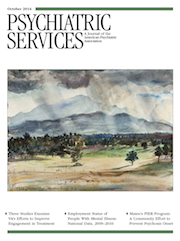This Month’s Highlights
Preventing Hospitalization for Psychosis
This month’s lead article reports on a communitywide program initiated in 2001 in Greater Portland, Maine, to reduce the incidence of psychotic disorders among young people. The Portland Identification and Early Referral (PIER) program helps care providers, teachers, parents, and others recognize youths at high risk. Program staff provide referred youths with treatment aimed at preventing long-term disability. To gauge the effects of this preventive intervention, William R. McFarlane, M.D., and colleagues examined whether the incidence of hospitalization for psychosis was reduced after the PIER program began accepting referrals. In addition, they compared hospitalization rates in Greater Portland with rates in aggregated urban areas of Maine (control areas). They found that the PIER program succeeded in reducing hospital admissions for first-episode psychosis by a third (page Original article: 1194).
Mental Illness and Employment
Research has shown that working is associated with economic, psychosocial, and clinical improvements among people with mental illness. To examine the impact of mental illness on employment status, Alison Luciano, Ph.D., and Ellen Meara, Ph.D., analyzed data from more than 77,000 respondents to the National Survey on Drug Use and Health, which includes well-established scales to distinguish participants with mild, moderate, and serious mental illness. They found that employment rates decreased significantly with increasing severity of mental illness: among respondents with no mental illness, 76% were employed, compared with 55% of those with serious mental illness. Employment rates were 69% and 62%, respectively, among those with mild and moderate mental illness. Nearly 40% of people with serious mental illness had incomes under $10,000 per year, compared with 23% of those with no mental illness (page Original article: 1201).
Medication Use: Three Non-U.S. Studies
Three studies examined medication use in other countries. In a study involving more than 12,000 schizophrenia patients in Quebec, Eric A. Latimer, Ph.D., and colleagues found that 12% were receiving a high dose of antipsychotics (>1,000 mg chlorpromazine equivalents) and 10% were taking multiple concurrent antipsychotics. The authors noted a “systematic propensity” for certain physicians—and physician groups at certain hospitals—to prescribe high doses, which led the authors to recommend audit and feedback mechanisms (page Original article: 1210). In a study in Costa Rica, a developing nation with near-universal insurance, Marisa Elena Domino, Ph.D., and colleagues found that the relationship between education level and use of psychotropic medications was different from that seen in the United States. In addition, patterns of antipsychotic use were very different in the two countries (page Original article: 1218). Analyzing data from Italy’s national database on medication consumption, Maria Rosaria Gualano, M.D., and colleagues documented a fourfold increase in antidepressant use between 2001 and 2011. The authors call for a public health response to reduce depression, such as educational interventions, lifestyle interventions, anxiety management training, and cognitive therapy (page Original article: 1226).
Three VA Studies of PTSD
Treatment for military service members and veterans with posttraumatic stress disorder (PTSD) is the subject of three reports. Among returning OEF/OIF service members who screen positive for PTSD, it has been widely documented that many do not seek treatment. In a randomized controlled trial, Tracy Stecker, Ph.D., and colleagues found promising results for a brief phone-based intervention. In a call lasting under one hour, a psychologist used cognitive-behavioral techniques to address up to three of the service member’s beliefs about treatment. Those who received the phone call entered treatment sooner and experienced more immediate reductions in PTSD symptoms than those who received usual care (page Original article: 1232). In recent years, the Department of Veterans Affairs (VA) has enhanced funding for specialized mental health programs, in particular for veterans with PTSD, despite a widespread belief that many veterans are reluctant to seek specialty care because of stigma concerns. Dolores Vojvoda, M.D., and colleagues found no grounds for such concerns in an analysis of data from the Connecticut VA Healthcare System, where veterans with PTSD were highly likely to receive care in specialty clinics. Only 13% of more than 4,100 veterans received PTSD treatment exclusively in primary care (page Original article: 1238). To monitor treatment of veterans with PTSD and assess outcomes, the VA established benchmarks for psychotherapy and pharmacotherapy. However, a study by Hana J. Shin, Ph.D., and colleagues determined that these benchmarks were achieved for few veterans with PTSD and that even among those who received adequate doses of treatment, outcomes were no better than for those who received less treatment (page Original article: 1244).



